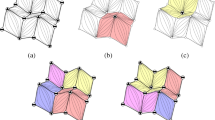Abstract
Hierarchical terrain models provide a multiresolution description of a topographic surface based on a nested partition of the domain. The tree-like structure of these models is an effective support to processing spatial operations. In this paper, we consider visibility computations on hierarchical terrain models based on triangular subdivisions, called Hierarchical Triangulated Irregular Networks (HTINs). We address two basic problems in visibility computation, namely determining the visibility of a query object, and computing the viewshed of a given viewpoint. We propose algorithms for performing such operations on an HTIN at variable resolution. A general drawback of hierarchical models is in the inconsistency of representations at variable resolution obtained from them, since vertical gaps may occur at edges where different resolutions meet. The algorithms proposed here avoid this undesired effect. A related, but independent, contribution of this paper is also a new algorithm for extracting a consistent terrain representation at variable resolution from an HTIN.
Similar content being viewed by others
References
Bertolotto, M., Bruzzone, E., De Floriani, L., “Acyclic Hierarchical cell complexes”, in Proc. 5th Canadian Conference on Computational Geometry, Waterloo, Ontario, Canada, pp. 279–284, 1993.
Boissonnat, J.D., Dobrindt, K., “On-Line construction of the upper envelope of triangles in IR3,” in Proc. 4th Canadian Conference on Computational Geometry, St.John's, Newfoundland, D.A. Wang (ed.), Memorial, Newfoundland, pp. 311–315, 1992.
Cignoni, P., Puppo, E., Scopigno, R., “Representation and visualization of terrain surfaces at variable resolution,” in Proc. Scientific Visualization '95, R. Scateni (ed.), World Scientific, Singapore, pp. 50–68.
Cole, R., Sharir, M., “Visibility Problems for Polyhedral Terrains,” Journal of Symbolic Computation, Vol. 17, pp. 11–30, 1989.
De Berg, M., Ray shooting, Depth Orders and Hidden Surface Removal, Lecture Notes in Computer Science 703, Springer Verlag, New York, 1993.
De Berg, M., Dobrindt, K., “On levels of detail in terrains,” in Proc. 11th ACM Symposium on Computational Geometry, Vancouver, BC (Canada), pp. c26–c27, 1995.
De Floriani, L., “A pyramidal data structure for triangle-based surface description,” IEEE Computer Graphics and Applications, pp. 67–78, 1989.
De Floriani, L., Falcidieno, B., Nagy, G., Pienovi, C., “Polyhedral terrain description using visibility criteria, Technical Report 17, Institute for Applied Mathematics, National Research Council, Genova, Italy, 1989.
De Floriani, L., Falcidieno, B., Nagy, G., Pienovi, C., “On sorting triangles in-Delaunay tesselation,” Algorithmica 6, Springer Verlag: New York, pp. 522–532, 1991.
De Floriani, L., Puppo, E., “A Hierarchical Triangle-based Model for Terrain Description,” in Theories and Methods of Spatio-Temporal Reasoning in Geographic Space, 1992, pp. 236–251, 1992.
De Floriani, L., Puppo, E., “Hierarchical Triangulation for Multiresolution Surface Description, ACM Transactions on Graphics, Vol. 14(4), pp. 363–411, 1995.
De Floriani, L., Puppo, E., Magillo, P., “A Formal Approach to Multiresolution Modeling,” in Theory and Practice of Geometric Modeling, W. Straßer, R. Klein, R. Rau (eds.), Springer-Verlag: Berlin, 1996.
Dyn, N., Levin, D., Rippa, S., “Data dependent triangulations for piecewise linear interpolation,” IMA Journal of Numerical Analysis, vol. 10(5), pp. 137–154, 1990.
Edelsbrunner, H., Guibas, L.J., Sharir, M., “The upper envelope of piecewise linear functions: algorithms and applications,” Discrete and Computational Geometry 4, Springer International: New York, pp. 311–336, 1989.
Felleman, J.P., Griffin, C., “The role of error in GIS-based viewshed determination —problem analysis,” Technical Report EIPP-90-2, Institute for Environmental Policy and Planning, State University of New York, New York, 1990.
Katz, M.J., Overmars, M.H., Sharir, M., “Efficient hidden surface removal for objects with small union size,” in Proc. 7th ACM Symposium on Computational Geometry, ACM Press: New York, pp. 31–40, 1991.
Magillo, P., De Floriani, L., “Computing Visibility Maps on Hierarchical Terrain Models,” in Proc. 2nd ACM International Workshop on Advances in Geographic Information Systems-ACM-GIS'94, Gaithersburg, MD, pp. 8–15, 1994.
McKenna, M., “Worst case optimal hidden surface removal,” ACM Transactions on Graphics, Vol. 6, pp. 19–28, 1987.
Nurmi, O., “A Fast Line-Sweep Algorithm for Hidden Line Elimination, BIT, Vol. 25, pp. 466–472, 1985.
Overmars, M., Sharir, M., “A simple output-sensitive algorithm for hidden surface removal,” ACM Transactions on Graphics, Vol. 11, ACM Press, New York, pp. 1–11, 1992.
Preparata, F.P., Shamos, M.I., Computational Geometry: An Introduction, Springer Verlag: Berlin New York, 1985.
Preparata, F.P., Vitter, J.S., “A simplified technique for hidden-line elimination in terrains,” Lecture Notes in Computer Science 577, Springer Verlag: Berlin New York, pp. 135–144, 1992.
Puppo, E., “Variable resolution terrain surfaces,” in Proc. Canadian Conference on Computational Geometry '96, pp. 202–210, also available as Technical Report 6-96, Institute for Applied Mathematics, National Research Council, Genova, Italy, 1996.
Reif, J.H., Sen, S., “An efficient output-sensitive hidden-surface removal algorithm and its parallelization,” in Proc. 4th ACM Symposium on Computational Geometry, Urbana, 1988, ACM Press, New York, pp. 193–200, 1988.
Rippa, S., “Minimal roughness property of the Delaunay triangulation,” Computer Aided Geometric Design, Vol. 7(7), 1990, pp. 489–497, 1990.
Samet, H., The design and analysis of spatial data structures, Addison-Wesley: Reading, MA, 1990.
Scarlatos, L.L., Pavlidis, T., “Hierarchical triangulation using terrain features,” in Proc. IEEE Conference on Visualization, San Francisco, CA, 1990, pp. 168–175, 1990.
Schmitt, A., “Time and space bounds for hidden line and hidden surface algorithms,” in Proc. Eurographics '81, North Holland, Amsterdam, pp. 43–56, 1981.
Author information
Authors and Affiliations
Rights and permissions
About this article
Cite this article
De Floriani, L., Magillo, P. Visibility Computations on Hierarchical Triangulated Terrain Models. GeoInformatica 1, 219–250 (1997). https://doi.org/10.1023/A:1009708413602
Issue Date:
DOI: https://doi.org/10.1023/A:1009708413602




